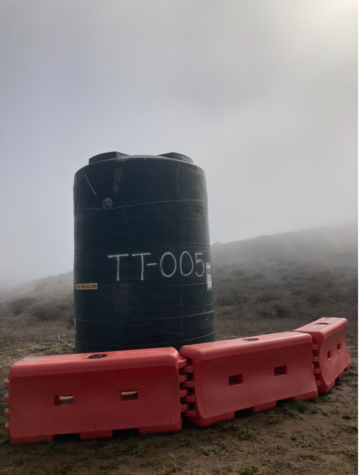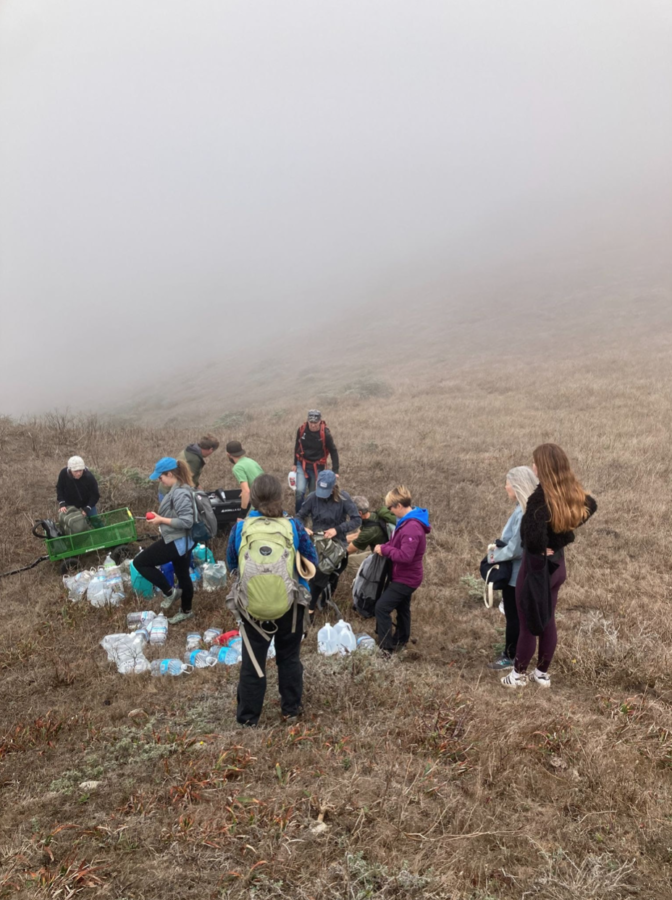Activists water Tule Elk on Tomales Point
Tule Elk activists unloading water from carts to transport to an abandoned cattle trough.
On Sept. 19, at 11 a.m., wildlife activists gave approximately 200 gallons of water to Tule Elk in Tomales Point at the Point Reyes National Seashore. These activists hope to access Elk restricted to the northern end of the 2,600 acre Elk sanctuary, who may not be able to easily access ponds at the park’s southern border.
When the Point Reyes National Seashore opened in 1962, Tule Elk were extinct from the then just-established National Seashore. According to the National Parks Service’s website, in 1978, the National Park Service reintroduced 11 Tule Elk to Tomales Point. Enclosed by a three mile fence extending from the Pacific Ocean to Tomales Bay on 2,600 acres of land, Tule Elk at Tomales Point began to thrive.
Although Tomales Point had been a good environment for animals in the past, due to this year’s intense drought and past dry winters, Tule Elk face limited water and food sources. Jack Gescheidt, Tule Elk activist and organizer of the watering event, says that although the installation of the Tule Elk sanctuary at Tomales Point was necessary, he believes that the Elk now live in a “zoo enclosure,” and believes the fence keeping the Tule Elk on Tomales Point should come down.
“If you’re gonna put up a fence and create an unnatural, fenced enclosure, you have to provide it with food and water too,” Gescheidt said.
Tule Elk activists can access Tule Elk via the Tomales Point Trail, a nine-mile hike starting at Pierce Point Ranch. In the past, activists have brought water to dried up ponds, or have brought makeshift water troughs with them from the Tomales Point Trailhead.

According to Gescheidt, the Park Service has taken down troughs that volunteers bring to fill with water for the Tule Elk, as they cannot allow the addition of new structures in the National Seashore. Often, the water in these troughs is siphoned off by the park service or dumped out altogether. To combat this, Gescheidt found an abandoned cattle trough about a fourth of a mile off the Tomales Point Trail, a mile from Pierce Point Ranch.
“Every time we’ve done it we used metal or heavy plastic cattle troughs, which are used for livestock typically,” Gescheidt said. “The park services then come, overturn them, dump the water out, and remove those containers. We don’t know exactly what they’ll do this time, because we are putting this in an existing structure.”

Although providing water for the Tule Elk is not illegal, the park service discourages people from doing so. Elk activists say that their attention has diverted to Elk on the northern tip of Tomales Point, as all the ponds now dried up. To prevent ponds on Tomales Point’s southern border from drying up, the Points Reyes National Seashore park service installed three water tanks that fill up the ponds.
Due to a lack of water on the Point, Anushka Drescher, Tule Elk activist and attendee of the Elk watering, says that Tule Elk now have limited food resources. Plants and grasses Tule Elk depend on are either too dry to eat or dead, causing them to eat unknown, possibly dangerous food substitutes.
“[Tule Elk] have been eating toxic weeds because the rest of the forage is too dry, so [Elk] have been dying a very slow and agonizing death from eating those weeds,” Drescher said.
According to Drescher, ranchers at the Point Reyes National Seashore were supposed to have vacated their ranches in 1987, due to negotiated buyouts with the National Park Service. Due to lease extensions, ranchers, many of whom have worked on their family ranches for decades, have now obtained new lease extensions that may last another 20 years. Drescher believes that the National Park Service should come up with a “different plan,” one involving ranchers leaving their properties and the fence at Tomales Point coming down.

“A different plan would mean making sure that the ranches…shut down, and opening up those grazing areas to the wild Tule Elk that are the natural grazers here,” Drescher said.
Despite growing Tule Elk populations in the 80s and the 90s, Tule Elk populations are declining once again. Laura Chariton, Tule Elk activist and attendee of the watering event, expects the Elk populations to plummet.
“152 [Tule] Elk have already been lost last year…we found a lot of dead bodies since then, and seen a lot of emaciated Elk,” Chariton said.
To prevent the park service from disposing of the water, Elk activists now work in shifts watching the cattle trough. As of now, Tule Elk activists are not planning a return to Tomales Point.


Henry is a senior in high school, who loves to play tennis and enjoys spending time outdoors hiking.







